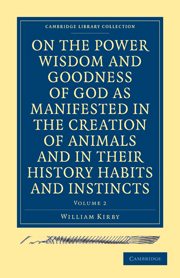Book contents
- Frontmatter
- Contents
- EXPLANATION OF PLATES
- CHAP. XIII Functions and Instincts. Cirripedes and Crinoïdeans
- CHAP. XIV Functions and Instincts. Entomostracan Condylopes
- CHAP. XV Functions and Instincts. Crustacean Condylopes
- CHAP. XVI Functions and Instincts. Myriapod Condylopes
- CHAP. XVII Motive, locomotive and prehensory organs
- CHAP. XVIII Instinct in general
- CHAP. XIX Functions and Instincts. Arachnidans, Pseudarachnidans, and Acaridan Condylopes
- CHAP. XX Functions and Instincts. Insect Condylopes
- CHAP. XXI Functions and Instincts. Fishes
- CHAP. XXII Functions and Instincts. Reptiles
- CHAP. XXIII Functions and Instincts. Birds
- CHAP. XXIV Functions and Instincts. Mammalians
- CHAP. XXV Functions and Instincts. Man
- CONCLUSION
- Index
- Plate section
CHAP. XVI - Functions and Instincts. Myriapod Condylopes
Published online by Cambridge University Press: 29 August 2010
- Frontmatter
- Contents
- EXPLANATION OF PLATES
- CHAP. XIII Functions and Instincts. Cirripedes and Crinoïdeans
- CHAP. XIV Functions and Instincts. Entomostracan Condylopes
- CHAP. XV Functions and Instincts. Crustacean Condylopes
- CHAP. XVI Functions and Instincts. Myriapod Condylopes
- CHAP. XVII Motive, locomotive and prehensory organs
- CHAP. XVIII Instinct in general
- CHAP. XIX Functions and Instincts. Arachnidans, Pseudarachnidans, and Acaridan Condylopes
- CHAP. XX Functions and Instincts. Insect Condylopes
- CHAP. XXI Functions and Instincts. Fishes
- CHAP. XXII Functions and Instincts. Reptiles
- CHAP. XXIII Functions and Instincts. Birds
- CHAP. XXIV Functions and Instincts. Mammalians
- CHAP. XXV Functions and Instincts. Man
- CONCLUSION
- Index
- Plate section
Summary
There are two Classes of Condylopes, extremely dissimilar in their external form and the number of their legs, and yet in some respects related to each other, at each of which we may be said now to have arrived; both are almost exclusively terrestrial, and both remarkable for their ferocious aspect; the one the analogue of the crab, and the other apparently related to the Isopod Crustaceans, the oniscus and armadillo. It will be easily seen that I am speaking of the Arachnidans and Myriapods.
Regarding, therefore, the long-tailed Decapod Crustaceans as leading, by the Order of Isopods which we last considered, towards the Myriapods, and the short-tailed ones or crabs, as tending towards the Arachnidans. I shall give a brief account of the former of these Classes in the present chapter, and I am the more induced to assign them precedency because of their evident connection with certain Annelidans, which indeed Aristotle, and other ancient Naturalists, thought was so close, that they considered them as belonging to the same genus, and it is worthy of remark that, in the Class just named, the representatives, if they may be so called, of the Myriapods, are, like them, divided into two tribes, one with a cylindrical and the other with a flat body.
- Type
- Chapter
- Information
- On the Power, Wisdom and Goodness of God as Manifested in the Creation of Animals and in their History, Habits and Instincts , pp. 63 - 92Publisher: Cambridge University PressPrint publication year: 2009First published in: 1835

